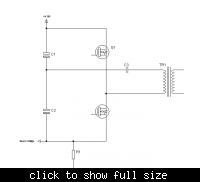grizedale
Advanced Member level 3
Hello
I must do half-bridge SMPS with vin = 390V and power = 200W
It must be very cheap so i dont want to have a current sense transformer as its expensive.
Instead i widh to have a current sense resistor, connected from the half bridge ground, back to the ground of the PFC
stage........i.e. the current sense resistor voltage goes below the ground of the half-bridge controller.
-howver, i cannot find a controller like this for half-bridge.
do you know why they don't exist.
This type of current sensing exists for LLC resonant controllers as in FAN7621.
I must do half-bridge SMPS with vin = 390V and power = 200W
It must be very cheap so i dont want to have a current sense transformer as its expensive.
Instead i widh to have a current sense resistor, connected from the half bridge ground, back to the ground of the PFC
stage........i.e. the current sense resistor voltage goes below the ground of the half-bridge controller.
-howver, i cannot find a controller like this for half-bridge.
do you know why they don't exist.
This type of current sensing exists for LLC resonant controllers as in FAN7621.
